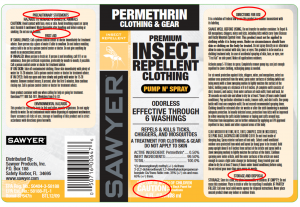“Frugality, I’ve learned, has its own cost, one that sometimes lasts forever.” – Nicholas Sparks

Some pesticides containing permethrin can be applied to clothing, footwear and gear to protect against mosquitoes, ticks, and other biting insects. Recent research confirmed that permethrin interferes with blacklegged, American dog, lone star and Asian longhorned ticks’ ability to move and, thus, to bite. EPA-registered products specifically designed for clothing contain 0.5% permethrin. A 22.5 oz. spray bottle claims to treat five outfits and costs $14. However, some people look to save money by buying a permethrin product meant for turfgrass or ornamental applications and diluting it to 0.5%. But what is the actual cost?
3 Reasons Why Making Your Own Permethrin Spray is a Bad Idea:
1) It probably won’t work. A pesticide product contains inert ingredients that help the active ingredient (in this case, permethrin) perform properly for the uses listed on the product label. Products used in clothing and gear sprays are uniquely suited for binding the permethrin to fabric and product labels tell you how long they will be effective (e.g., six weeks or six washes, whichever comes first). If you make a DIY spray with a permethrin product designed for other uses, it won’t bind as well to your clothes; thus, there is no way to know if it will work or for how long, putting you at risk for a tick bite.
2) You could be putting yourself, others, pets, non-target animals, and the environment at unacceptable risk. Permethrin can be harmful if absorbed through the skin and if a product is not designed to bind the permethrin to your clothing, the insecticide will instead move from the clothing onto your skin. For your protection, the EPA will register the use of a pesticide only if rigorous safety testing shows it will “pose no unreasonable risks to people or the environment when used according to label directions.” Only those uses listed on a pesticide label have met this standard, and treating clothing and gear is NOT a use listed on the label of other permethrin products.
3) It is against the law. Because of Reason #2, the first sentence in the Directions for Use section of all permethrin products is “It is a violation of federal law to use this product in a manner inconsistent with its labeling.” Which, by the way, also means it is against your state’s laws.
Commercially available permethrin clothing and gear sprays cost more because it takes time and money to develop the right mix of ingredients and conduct the required safety testing to ensure that the product will control ticks without putting people and the environment at risk. DIY treatments that pose greater risks while providing poorer control of ticks are hardly a bargain; be sure to use the real thing and follow all label directions.
For more information about permethrin, visit the National Pesticide Information Center and EPA. And for more information on ticks, tick-borne diseases, why there are so many of them, and how to protect yourself, check out www.dontgettickedny.org.
Authors:

- Dan Wixted, Cornell University Pesticide Management Education Program
- Joellen Lampman, New York State Integrated Pest Management Program